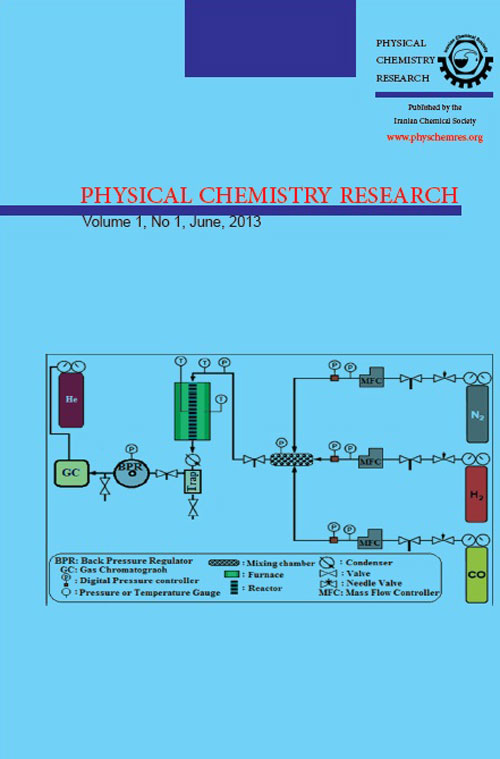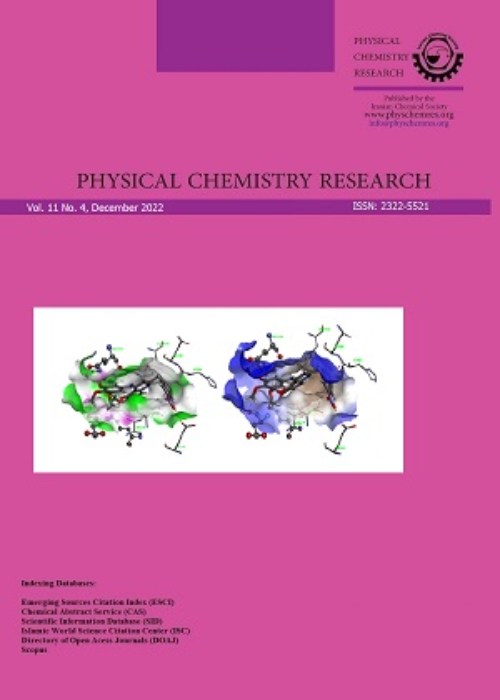فهرست مطالب

Physical Chemistry Research
Volume:1 Issue: 1, Spring 2013
- تاریخ انتشار: 1392/09/28
- تعداد عناوین: 8
-
-
Pages 1-33
A nanofluid is a dilute liquid suspension of particles with at least one critical dimension smaller than ~100 nm. Research works so far suggest that nanofluids offer excellent heat transfer enhancement over conventional base fluids. The enhancement depends on several factors such as particle shape, particle size distribution, volume fraction of nanoparticles, temperature, pH, and thermal conductivities of nanoparticles and base fluids. This paper presents an updated review on nanofluids with the emphasis on heat transfer enhancement including formulation, physical properties such as thermal conductivity, rheological properties, and surface tesion, biological and non-biological applications, stability, possible mechanisms for the enhancement of heat conduction, and numerical modelling of nanofluids. Based on the research findings, a number of challenges are emphasized in order to understand the underlying physics for future industrial take-up of the nanofluids technology. Further computational studies are also required in order to understand all of the factors affecting on the enhancement of thermal conductivity of nanaofluids.
Keywords: Heat transfer enhancement, Nanofluids, Thermal Conductivity, Viscosity -
Pages 34-40
In this article, the second quantization method has been used to investigate some thermodynamic properties of spin-polarized metallic nanowire in the presence of magnetic field at zero temperature. We have been observed that in different magnetic field, the equilibrium energy of system increases as the density increases. The spin-polarization parameter corresponding to the equilibrium state of the system has been plotted as a function of density for different values of the magnetic field. We have concluded that for the magnetic fields less than 100 T at high densities, the system nearly becomes unpolarized. However, for higher magnetic fields, the system has a substantial spin-polarization, even at high densities. Finally, we have calculated the kinetic pressure and incompressibility versus the density for different values of the magnetic field. It is obvious that as the density increases both of them increase and the difference between them at different magnetic field becomes more appreciable.
Keywords: Metallic nanowire, Second quantization, Electron gas, Spin-polarization -
Pages 41-51
The structural and energetic characteristics of O3H2O complexes have been investigated by means of B3LYP, MP2, MP4(SDTQ), CCSD(T) and QCISD(T) methods in conjunction with the AUG-cc-pVDZ and AUG-cc-pVTZ basis sets. Six conformers were found for the O3H2O complex. Two different intermolecular interactions were expected to participate in the formation of complexes, namely conventional O∙∙∙H hydrogen bonding and O∙∙∙O interaction. The most stable structure is non-hydrogen bonded one with double O∙∙∙O interactions. The binding energies of the most stable complex corrected with BSSE and ZPE range from -5.99 to -12.20 kJ/mol at CCSD(T)/AUG-cc-pVTZ, QCISD(T)/AUG-cc-pVTZ and MP4(SDTQ)/AUG-cc-pVTZ high levels of theory. The equilibrium distance between centers of monomers (O3∙∙∙OH2) in the most stable complex at the CCSD(T)/AUG-cc-pVDZ and CCSD(T)/AUG-cc-pVTZ levels is 2.9451 and 2.9448 Å, respectively, in good agreement with the experimental value of 2.957 Å. The AIM calculations predict that the O∙∙∙O and O∙∙∙H interactions in O3H2O complexes are electrostatic in nature.
Keywords: O3-H2O complexes, Quantum chemical calculations, Non-hydrogen bonded interaction -
Pages 52-60
This study demonstrates the spectral data for two triarylmethane dyes, malachite green (MG) and crystal violet (CV) at room temperature. Effects of micellar environment, and crown ether addition on the spectral behaviour of the dyes were studied using absorption spectroscopic method. The dye-anionic surfactant interactions in micellar media were investigated. The chosen surfactants with different alkyl chain length were SOS, STS, SHS and SDS. The effect of a crown-ether (i.e. aza-15-crown-5) addition on the absorption spectra and decolorization of the dyes was also studied at room temperature. Moreover, the effect of crown ether addition on the micellar properties of the media was also studied and compared. Spectroscopic analysis of the dyes shows that the dye decolorization can be accelerated by the crown ether. Conversely, the decolorization can be inhibited in the micellar media. The nature of decolorization process was interpreted through direct and indirect mechanisms of crown-ether and the dye interactions.
Keywords: Triarylmethane dyes, Dye-surfactant interactions, Crown ether addition, decolorization -
Pages 61-68
Molecular dynamics simulation has been performed to analyze the effect of the presence of gold nanoparticle on dynamics of Kob-Anderson binary Lennard-Jones (BLJ) mixture upon supercooling within the framework of the mode coupling theory of the dynamic glass transition. The presence of gold nanoparticle has a direct effect on the liquid structure and causes the peaks of the radial distribution functions to become shorter with respect to the bulk binary Lennard-Jones liquid. It is found that the dynamics of the liquid at a given density is consistent with the mode coupling theory (MCT) predictions. In accordance with the idealized MCT, the diffusion constants D(T) show power-law behavior at low temperatures for both types of BLJ particles as well as the 13 gold atoms comprising the nanoparticle. The mode coupling crossover temperature T_c is the same for all particle types, however, T_c= 0.4 is reduced with respect to that of the bulk BLJ liquid and the exponent is found to depend on the particle type. The existence of the nanoparticle causes the β-relaxation regime to shorten and the range of validity of the MCT shrink with respect to the bulk BLJ. It is also found that the behavior of intermediate scattering function is in agreement with MCT prediction and in spite of the presence of gold nanoparticle the time temperature superposition principle at intermediate and low temperatures is still valid and the curves of ISF versus t/τ (T) fall onto a master curve.
Keywords: Molecular dynamics simulation, Mode coupling theory, Glass Transition, Nanofiller -
Pages 69-80
The kinetic of Fischer-Tropsch synthesis over a co-precipitated Fe-Ce catalyst was investigated in a fixed bed micro reactor. Experimental conditions were varied as follow: reaction pressure 1-15bar, H¬¬¬2/CO feed ratio of 1-3 and space velocity of 3600-5400 h-1 at the temperature range of 270-310°C. 4 models according to the Langmuir-Hinshelwood-Hougen-Watson (LHHW) type rate equation were derived on the basis of detailed set of possible reaction mechanisms and the reaction rate of this study is fitted fairly well by one kinetic expression based on LHHW mechanism. The kinetic parameters were estimated with non-linear regression method and the MARR% values for all proposed models were obtained. The activation energy was 72kJ/mol for optimum kinetic model and this model has the lower MARR% value than the other proposed models.
Keywords: Fischer-Tropsch synthesis, Co-precipitation, Kinetic Model, Fe-Ce catalyst -
Pages 81-89
The effect of interactions of various Ia and IIa cations with two positions of the adenine-thymine (A−T) and guanine-cytosine (G−C) base pairs on the geometries and individual hydrogen bond (HB) energies have been investigated by using the atoms in molecules (AIM) method at the B3LYP/6-311(d,p) level of theory. The cations that possess higher charge/radius (q/rad) ratio make higher changes on the individual HB energies and the total binding energies of G−C base pair, while no meaningful changes are observed for the A−T base pair. The effect of coordination with cations on the H-bond energies of A−T type complexes, especially in the X''A−T derivatives, is slight and different from the G−C complexes. The changes of total binding energies are most important in the presence of bivalent cations. The estimated individual EHBs are in good agreement with the results of natural bond orbital (NBO) analysis and also with the structural parameters of HBs.
Keywords: Individual hydrogen bond, electron density, base pair, adenine-thymine, guanine-cytosine -
Pages 90-98
The structural and electrostatic properties of the single-walled two representative (8, 0) zigzag and (4, 4) armchair models of pristine and GaAs-doped on boron phosphide nanotubes (BPNTs) was investigated by calculating the nuclear magnetic resonance tensors and with performing the density function theory. The geometrical structures of all representative pristine and GaAs-doped models of BPNTs have been allowed to relax by optimization and then the isotropic and anisotropic chemical shielding (CS) parameters (CSI and CSA) of 11B and 31P have been calculated. The results reveal that with doping gallium and arsenic atoms in spite of boron and phosphorus atoms, the geometrical structure, the band gape energy between Homo and Lumo orbital and NMR parameters of the boron and phosphorus sites changed. The comparisons of results reveal that the variation NMR parameters and band gape energy of zigzag model are more than armchair model. The NMR properties of boron atoms only detect slight changes but those of phosphorous atoms are more notable
Keywords: BPNTs, NMR parameters, DFT method, GaAs, doped


